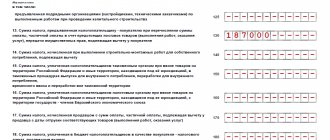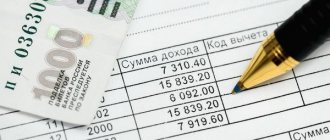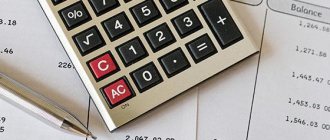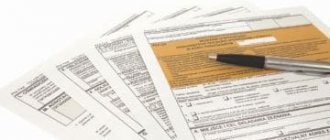The VAT return submitted by an enterprise is a source of information for the tax authorities about the amount of calculated tax and deductions. During the inspection, inspectors check the correctness of filling, completeness of calculations, and the reliability of the information provided. One of the indicators reflected in the tax return and monitored by the tax office is the specific weight of the deduction. For Russian cities, the Federal Tax Service has established safe values for this indicator. The average statistical threshold for VAT deduction in Russia is 87.9%. Inspectors pay attention to enterprises that indicate a high proportion of deductions, because this is considered serious evidence that the enterprise has a weak tax burden. And the problem becomes the reason for sending a request to the organization to provide explanations, and then the reason for ordering an on-site inspection. In order to remove suspicions from the organization regarding the legality and legality of transactions carried out in accounting and tax accounting, it is recommended to promptly provide inspectors with an explanatory note about the reason that provoked the increase in the share. Some accountants act proactively and, without waiting for requirements from the inspection, attach to each VAT return a letter of reference about the level of the share of VAT deductions and indicate what share of profit deductions in the organization for the reporting period, and give the necessary explanations.
How to calculate the share of VAT deductions in 2021
The share of tax deductions for VAT is an indicator of assessing the state of affairs in the organization. Organizations that do not wish to provide information to the inspectorate about the reason for reducing the tax burden risk being included in the list of those who received notification of the appointment of an on-site inspection. If an organization, when compiling information on the tax burden at an enterprise, finds itself at risk according to this criterion, it is recommended to submit an explanation to the tax office about the reasons for the current situation, without waiting for requirements from the inspectorate. Calculation of the share of deductions and comparison with the threshold value approved for 2021 for the region in which the organization operates will help to assess the risks. This indicator represents the percentage of VAT deductions in the amount of accrued VAT. For the calculation, only two values from the declaration are required:
- Line 190 “VAT deductible”;
- Line 110 “VAT accrued”.
We calculate the indicator: VAT deductible / VAT accrued * 100%. An indicator in dynamics is informative, that is, a change in the values of the indicator over two or three reporting periods. Having carried out the necessary calculations, we will find out what percentage of the accrued VAT the organization deducts. This value is compared by tax authorities with a threshold value in order to identify the degree of VAT tax risks in the organization. Organizations with a threshold value higher than that approved in the region in which the organization is registered immediately come under the close attention of inspectors. An example of calculating the share of VAT deductions for an organization (Moscow) According to information from the declaration for the 1st quarter, VAT was charged in the amount of 1,000,000 rubles. The tax deduction for the 1st quarter amounted to 900,000 rubles. The share of VAT deductions = 900,000 / 1,000,000 * 100% = 90% Let us turn to the background information of the internal reporting of the Federal Tax Service of Russia (report on form No. 1-VAT). For the date we are interested in, we establish that the share of tax deductions for VAT in 2021 (Moscow) is 89.9%. In our case, the share of VAT deductions exceeds 89%, explanations for the tax office in this case will be useful, since this is more than the threshold value for Moscow, which means the organization faces a call to the tax office to give explanations. If the share of tax deductions for VAT exceeds 89%, what should I answer to the tax office?
What is the share of VAT for organizations and individual entrepreneurs?
The share for organizations and entrepreneurs is calculated for each individual and depends on the size of the tax base and the region of registration of the entrepreneur or enterprise. It can also be influenced by indicators such as the scope of activity or business profitability.
Important ! For each region, the ratio of the possible deduction to the tax base may be different. However, in the Russian Federation on average as of January 1, 2021 it was 88.06%.
High share of tax deductions for VAT. Response to the tax office
After submitting your VAT return, did the tax office receive a request to provide an explanation for the high share of VAT deductions? An example of an explanation is easy to find in open sources, but it is not worth wasting time because explanatory documentation can be provided in any form. It is recommended to indicate that:
- the indicators indicated in the declaration are correct, re-checked and approved in the previous values;
- the organization did not make errors or incompletely reflect information, and clarification is not required;
- The organization has taken measures to increase these indicators in the next reporting period and reduce the share of VAT tax deductions.
It is recommended to decipher and attach to the explanatory note the calculation of the disputed values of the indicators and documentation confirming the information provided in the documentation. To explain why an organization has a high share of VAT tax deductions, an explanation (it is difficult to find a suitable example, because the reasons for each organization are individual) should be provided with the requested documentation attached within five banking days. Without providing written explanations on the issues requested by the inspectors, the entrepreneur is not liable before the law. But a timely response to the tax authorities’ demands on a voluntary basis will save the organization from problems with unreasonable penalties, which inspectors, at their discretion, will impose on the enterprise on controversial issues. Unfortunately, in such situations, controversial issues are resolved not in favor of the organization. Of course, the tax inspectorate evaluates the tax risks of companies based on more than one indicator, so just exceeding the values established on the basis of statistical information will not be the reason for an audit, but it will certainly be the basis for additional demands from inspectors. It is fair to note that, working within the specified indicator, an entrepreneur is not immune from tax audits. So, before submitting the declaration, the leaders of the organization should check such an indicator as the share of tax deductions for VAT, because exceeding the threshold value will provoke a keen interest in the company on the part of the inspection authorities. Although, if the company’s business is legitimate and legal in nature, and the transactions are not related to “fly-by-night companies,” then both the accountant and the director have nothing to fear and have something to provide tax officers with as an objection to the claims. For example, to indicate the objective reasons for the high share of tax deductions for VAT, we will consider a sample explanation.
Table of deductions for various regions
Data on the safe share of deductions concerns 85 regions of our country. Each region has its own percentage of deductions, which is not recommended to be exceeded. We present the latest official data for some regions in the table.
| Region | Safe deduction share, % |
| Central Federal District | |
| Vladimir region | 85,2 |
| Ivanovo region | 92,6 |
| Moscow region | 90,4 |
| Northwestern Federal District | |
| Arhangelsk region | 82,1 |
| Kaliningrad region | 62,9 |
| Leningrad region | 81,7 |
| Nenets Autonomous Okrug | 121,1 |
The tables posted on the Internet are generally quite voluminous. Data are usually presented in comparison with previous periods. In most cases, the safe corridor for deductions varies from 80% to 100%. The lowest share of deductions is possible at Baikonur. There this figure is 57.9%.
How to explain the high share of VAT tax deductions
The task of the head of the organization, in the case of high values of the share of VAT deductions, is to reduce the risk of including the enterprise in the on-site inspection plan, and therefore to prove that the reasons for this are objective. In each specific case, the organization provides period-appropriate reasons why the share of tax deductions exceeds the threshold value. How to explain to the tax authorities the high proportion of VAT deductions? Let's consider five reasons, as a sample explanation to the tax office about the high share of tax deductions for VAT. They can explain the occurrence of such a situation in the organization.
Reason 1. The company has just recently been registered
Organizations whose business is just starting do not have a sufficient market, but a “young” company has plenty of expenses. For example, invoices for office and warehouse rent, advance payment for electricity, Internet connection, telephone connection, purchase of goods to a warehouse for subsequent resale, etc. In this situation, the organization has a lot of expenses, but sales have not yet been established and do not generate enough income to cover expenses. In the explanations for the inspector, we indicate the reason for the increase in the indicator: “Due to the start of business activities, the company’s costs exceed its income. To organize the work of the office and warehouse, the necessary equipment and furniture were purchased, and the services of companies providing communication services were paid for. Advance payments have been made to connect the company to electricity and heating. Products have been delivered to the warehouse, the sale of which is planned for the next quarter.” As an appendix, we provide constituent documentation confirming the date of registration of the company, as well as all primary documents confirming the listed costs: invoices, accounting cards, contracts, invoices, acts for the provision of services, etc.
Reason 2. Replenishment of goods for subsequent resale
For example, the head of an organization issued an order to stock the warehouse with products that will become more expensive in the next quarter, so buying goods in advance means acquiring additional profit from the difference in price. As a result, the warehouse will be replenished with goods, and a high proportion of deductions will be reflected in tax accounting. In the explanations we indicate: “replenishment of the warehouse with goods for subsequent sale in a future period.” We attach documents confirming the accuracy of the information provided: accounting cards confirming the receipt and balance of goods in the warehouse, a copy of the agreement for the purchase of products, invoices.
Reason 3. Seasonality of business
Sales volumes of some types of goods depend on seasonality, for example, products for winter fishing or lawn mowers. Sales of such goods practically cease outside the season for which they are intended for use. However, costs, for example, for storage and warehouse maintenance, remain. Therefore, the deductions are high. In the explanations we indicate: “seasonality of the product.” We attach documents confirming the availability of expenses and balances in the warehouse.
Reason 4. Late receipt of invoices from counterparties
An invoice can be accepted for deduction only upon receipt of it from the counterparty. Upon receipt of the original invoice, the organization records its receipt by mail in a special journal. But, unfortunately, the post office is not always impeccable in the quality of the services provided, and correspondence is “delayed” and sometimes completely lost. It is not surprising that invoices are received by the accounting departments of organizations with a delay. As a result, we accept some invoices for deduction in the tax period following their issue. The law provides for the possibility of submitting an invoice at a later date; it is enough to attach an explanation justifying such actions on your part. In the explanations we indicate: “acceptance for deduction of invoices issued in the previous tax period due to a delay in the receipt of the specified documentation by the organization.” We attach documents confirming the accuracy of the information provided: an extract from the invoice register, a copy of the invoice itself, an extract from the purchase book about the absence of the specified invoices in the previous tax period.
Reason 5. Small trade margin (during resale) or small added value (during production)
The market sets the price level above which the organization cannot set the price of the goods it sells. Therefore, in order to maintain their position in the market, some companies set minimum markups and surcharges on products. During production, a situation may additionally arise when raw materials for production are purchased at a VAT rate of 10%, and sales at 18%. In the explanations we indicate: “a small trade margin in order to maintain the competitiveness of the organization.” We attach documentation confirming the accuracy of the information provided: copies of contracts for the purchase of goods or raw materials, invoices for the purchase and shipment of products. Of course, these are just some of the reasons that will be accepted by the inspector as an explanation to the tax office about the high share of VAT deductions (sample: reason 1).
Distribution of “input” VAT in trade
The procedure for deducting “input” (“import”) VAT <1> (hereinafter referred to as “input” VAT) largely depends on the rates at which VAT is applied to sales turnover. If an organization sells objects taxed at different rates, it may be necessary to distribute “input” VAT. Let us consider the procedure for such distribution if a trade organization has turnover in the sale of goods on the territory of Belarus in wholesale trade, subject to VAT at rates of 20, 10, 0% and exempt from VAT, and for retail it applies the estimated VAT rate.
When is “input” VAT distributed?
The total amount of VAT calculated on sales is reduced by tax deductions in the order by law <2>.
The “input” VAT reflected <3> is subject to deduction:
- in accounting (the basis for the accounting entry is the primary accounting document);
- purchase ledger, if the accounting policy provides for its maintenance.
Input VAT can be deducted only if there is an ESCF signed by the organization <4>.
Note : In relation to VAT paid on the import (except for import from the EAEU countries) of goods intended for sale in an unchanged state (form), or goods whose purpose of use is unknown (not determined), a 60-day deferment of deduction is applied <5>.
If an organization sells goods (work, services, property rights), tax deductions for which are made in different ways, it needs to determine the amount of “input” VAT that is subject to deduction in different ways. Consequently, there is a need to distribute “input” VAT between turnovers for which different deduction procedures are applied, in particular, different order of deductions <6>. Let us remind you that the “input” VAT for which all conditions for deduction are met is distributed.
Note : The Organization has the right to attribute “input” VAT to the increase in the cost of acquired objects (including fixed assets (fixed assets) and intangible assets (intangible assets)). If she exercises this right, then these amounts of VAT are not deductible. Accordingly, they are not distributed among sales turnover <7>.
In addition, the organization may need to determine the amounts of “input” VAT that cannot be deducted and should be attributed to costs, to the cost of acquiring objects <8>.
The order of deductions, as well as the presence of VAT amounts not accepted for deduction (attributable to costs), is influenced by the applicable VAT rate on sales turnover . In addition, there are features in the procedure for deducting “input” VAT on fixed assets and intangible assets (see table below) <9>.
A feature of retail trade , as well as public catering, is the ability to calculate VAT on the sale of goods based on the calculated rate, if they are recorded in account 41 “Goods” at retail prices. To use it, <10> must be provided:
- separate accounting of VAT amounts included in the price of goods. Such accounting is kept in account 42 “Trade margin”;
- separate accounting of turnover for the sale of goods taxed at different rates.
If at least one of these conditions is not met, a rate of 20% is applied to the turnover of goods sold at retail.
| VAT taxation of sales turnover <*> | Procedure for deducting input VAT | |
| for purchased goods, works, services, property rights (except for fixed assets and intangible assets) | on OS and intangible assets | |
| At a rate of 20% | Accepted for deduction within the amount of VAT calculated on sale. First order of deduction | Accepted for deduction within the limits of the amount of VAT calculated on the sale, reduced by the VAT, which is deducted first. Second order of deduction |
| At estimated rate | Same <**> | Same <**> |
| At a rate of 10% | It is accepted for deduction in full, regardless of the amount of VAT on sales. Third order of deduction | |
| At a rate of 0%<***> | It is accepted for deduction in full, regardless of the amount of VAT on sales. Fourth order of deduction | |
| Released | Not deductible: • applies to the cost of goods (in relation to the “input” VAT paid when importing goods, the sales turnover of which is exempt from VAT); • included in costs | Accepted for deduction within the amount of VAT on sales, reduced by the VAT deducted first <****>. Second order of deduction |
Please note that the cost of goods sold in retail (catering) that are exempt from VAT is also included in determining the settlement rate. However, there is no need to allocate “input” VAT attributable to this turnover and attribute it to costs. Such turnover in the VAT tax return is not included in line 8 “For transactions exempt from VAT”, but is included in line 10 “For transactions involving the sale of goods at retail prices”. Similarly, the “input” VAT attributable to sales at a rate of 10% is not allocated (this turnover is included in the turnover on line 10, and is not shown on line 3 “For transactions taxed at the rate of 10/110”) <11>.
Example 1
A trading organization carries out retail trade in goods and applies the calculated VAT rate to these turnovers. In addition, she is engaged in wholesale trade and has: • option 1 - turnover at a rate of 20%; • option 2 - turnover at rates of 10 and 20%. In option 1, there is no need to distribute tax deductions, since the same procedure for deducting “input” VAT applies to turnover taxed at a rate of 20% and the calculated rate. It is deductible within the limits of VAT on sale. In option 2, “input” VAT must be distributed, since the procedure for deducting “input” VAT related to wholesale turnover at a rate of 10% differs from the procedure in force for turnover at a rate of 20% and the calculated rate: • “input” VAT related for sale at the estimated rate and at the rate of 20%, is accepted for deduction within the limits of VAT on sales; • “input” VAT related to sales at a rate of 10% is accepted for deduction in the third place in full, regardless of the amount of VAT on sales.
How can you distribute “input” VAT?
The legislation provides for two methods of distributing the total amount of “input” VAT between turnovers, according to which the deduction procedure differs or the “input” VAT is charged to costs <12>:
1) separate accounting method;
2) specific gravity method.
The organization independently chooses which method it will use and consolidates its decision in its accounting policies. If it does not do this, then the default method should be the specific gravity method <13>.
You can also combine the methods of separate accounting and specific gravity, i.e. apply different methods to different activities or operations.
Only the specific weight method determines the amounts of “input” VAT on fixed assets and intangible assets of the current year , related to sales turnover, taxed at rates of 0 and 10% <14>.
Some peculiarities exist regarding the amounts of last year’s “input” VAT on fixed assets and intangible assets that were not accepted for deduction at the beginning of the year. Such amounts can be <15>:
- distributed among sales turnover by specific gravity , if the deduction for these turnovers is made in a different order, i.e. distribute in the same way as “input” VAT on fixed assets and intangible assets of the current year ;
- not to distribute between turnovers, but to deduct in equal shares, regardless of the amount of VAT on sales (deduction order is sixth);
- not to distribute between turnovers, but to accept for deduction within the limits of VAT on sales (deduction order is second), if it is determined that deductions from the previous year are not included in the distribution of deductions using the specific weight method.
The selected option is indicated in the accounting policy. Otherwise, the first option should be used by default.
As a rule, the specific weight method is applied to “input” VAT on costs associated with managing This is explained by the fact that such costs are usually associated with the management of the organization as a whole <16> and it is impossible in all cases to determine exactly which sales turnover they relate to.
The separate accounting method assumes that the organization has information about the amounts of “input” VAT that are accepted for deduction, included in costs, or applied to increase the cost of objects in the same manner.
To use it you need to provide <17>:
- separate accounting of such VAT amounts in accounting;
- maintaining separate purchase books (if, according to the organization’s accounting policies, this register is used).
Example 2
A trading organization sells goods at retail with VAT calculated at the estimated rate. Goods are sold wholesale, taxed at rates of 10 and 20% and exempt from VAT. The accounting policy determines that the “input” VAT on goods is distributed using the separate accounting method between wholesale turnover and retail turnover. Separate accounting is not maintained for amounts of “input” VAT on management costs. There is also no purchase ledger. In such a situation, “input” VAT attributable to wholesale turnover according to separate accounting data is further distributed using the specific weight method between turnover taxed at rates of 10 and 20%, as well as exempt turnover. “Input” VAT on management costs is distributed using the specific weight method between wholesale turnover exempt from VAT, wholesale turnover at a rate of 10%, wholesale turnover at a rate of 20% and retail turnover at a calculated rate. Only “input” VAT related to taxable turnover can be deducted. In particular, VAT relating to turnover taxed at a rate of 20% and the calculated rate is taken as a deduction within the limits of the calculated tax, and attributable to turnover at a rate of 10% is taken for deduction regardless of the accrued VAT.
When using the specific gravity method, the amount of “input” VAT attributable to a particular turnover is determined as follows <18>:
The distribution is made on an accrual basis from the beginning of the year.
VAT amounts for fixed assets and intangible assets are distributed separately.
Please note that if the validity of applying the 0% rate has not been confirmed and the confirmation period has not expired, the corresponding turnovers are not included in the amount on line 6 of the VAT return, intended to reflect the tax base for transactions taxed at the 0% rate. Consequently, these turnovers do not participate in the distribution of tax deductions. Note that if the application of the 0% rate is not confirmed at the end of the deadline, VAT on sales turnover is calculated using rates <19> for these goods.
Amounts of “input” VAT not accepted for deduction at the beginning of the year (including “input” VAT on fixed assets and intangible assets) are not included in the distributed amount of “input” VAT if the organization establishes such a procedure in its accounting policy <20>.
As noted above, an organization can use both methods of distribution (share and separate accounting). In this case, the total amount of turnover does not include sales turnover, to which separate accounting is applied. And the corresponding amount of “input” VAT does not participate in the formation of the distributed VAT amount for the specific weight method.
Example 3
The trading organization sells wholesale goods subject to VAT at rates of 10 and 20% and also exempt from VAT. In addition, goods are exported to other countries. The estimated VAT rate is applied to the sale of goods in stores.
There is no purchase ledger.
According to the accounting policy:
- “input” VAT on wholesale and retail trade is accounted for separately (except for “input” VAT on management costs);
- the balance of “input” VAT on fixed assets and intangible assets, not accepted for deduction at the beginning of the year, does not participate in the distribution by specific weight and is accepted for deduction within the limits of VAT on sales.
The method for distributing deductions related to wholesale sales turnover is not defined in the accounting policy. By default, they are distributed according to their share between wholesale sales turnover, subject to VAT at different rates, as well as exempt turnover.
The method for distributing “input” VAT among management costs is not specified. Consequently, it is distributed among all turnovers, the “input” VAT on which is deducted in different order (attributed to costs), using the specific weight method.
Turnovers from sales of goods for January - June (cumulative total from the beginning of the year, including VAT) amounted to:
- in retail trade at the estimated rate - 130,000 rubles. (including VAT RUB 16,580);
- wholesale trade:
at a rate of 20% - 120,000 rubles. (including VAT 20,000 rub.);
rate 10% - 55,000 rub. (including VAT 5000 rub.);
exempt turnover - 30,000 rubles;
for export - 70,000 rubles, including 65,000 rubles subject to reflection in the VAT return. Sales turnover in the amount of 5,000 rubles. is not reflected in the declaration, since documents confirming the zero rate have not been received. The deadline for their submission has not expired.
In addition, during the specified period, a penalty was received from a Belarusian buyer for late payment for goods taxed at a rate of 20% in the amount of 480 rubles, calculated from a VAT penalty of 80 rubles. (this amount increases the tax base in accordance with accounting policies on the date of receipt <21>).
The total amount of VAT calculated for January - June is 41,660 rubles. (16,580 + 20,000 + 5000 + 80).
The amount of “input” VAT from the beginning of the year (reflected in accounting, ESCHF received and signed) amounted to 31,000 rubles , including:
- for goods in wholesale (according to separate accounting) - 17,000 rubles;
- for retail goods (according to separate accounting) - 8,000 rubles;
- management costs - 2000 rubles;
- purchased OS - 4000 rubles.
The balance not accepted for deduction on fixed assets and intangible assets at the beginning of the year is 31,000 rubles.
The total amount of sales turnover used for the distribution of “input” VAT on wholesale trade will be 270,480 rubles. (120,000 + 55,000 + 30,000 + 65,000 + 480).
Turnover from the sale of goods at retail does not participate in the distribution of “input” VAT on goods in wholesale, since separate accounting was kept for them.
When determining the total amount of sales turnover used to distribute “input” VAT on management costs and on fixed assets acquired in the current year, it is necessary to take into account the turnover on retail sales of goods. The total amount of turnover is 400,480 rubles. (270,480 + 130,000).
The amount of goods sold for export, for which documents confirming the zero rate have not been received, the deadline for submission of which has not expired, does not participate in the distribution of “input” VAT in the period under review, since it is not reflected in the VAT tax base in the declaration.
Table 1
| Sales turnover | Distribution of “input” VAT on wholesale goods | ||
| Calculation | Amount, rub. | Deduction order | |
| Released | 17 000 × (30 000 / 270 480) | 1885,54 | — (referred to as costs) |
| At a rate of 10% | 17 000 × (55 000 / 270 480) | 3456,82 | Third |
| At a rate of 0% | 17 000 × (65 000 / 270 480) | 4085,33 | Fourth |
| At a rate of 20% | 17 000 – 1885,54 – 3456,82 – 4085,33 | 7572,31 | First |
“Input” VAT on retail goods (8,000 rubles), determined according to separate accounting data, is subject to deduction within the limits of the calculated VAT on sales in the first place.
table 2
| Sales turnover | Distribution of “input” VAT by management costs | ||
| Calculation | Amount, rub. | Deduction order | |
| Released | 2000 × (30 000 / 400 480) | 149,82 | — (referred to as costs) |
| At a rate of 10% | 2000 × (55 000 / 400 480) | 274,67 | Third |
| At a rate of 0% | 2000 × (65 000 / 400 480) | 324,61 | Fourth |
| At 20% rate and settlement rate | 2000 – 149,82 – 274,67 – 324,61 | 1250,90 | First |
Table 3
| Sales turnover | Distribution of “input” VAT for the current year’s assets | ||
| Calculation | Amount, rub. | Deduction order | |
| At a rate of 10% | 4000 × (55 000 / 400 480) | 549,34 | Third |
| At a rate of 0% | 4000 × (65 000 / 400 480) | 649,22 | Fourth |
| At the rate of 20% and settlement rate, exempt | 4000 – 549,34 – 649,22 | 2801,44 | Second |
Based on the accounting policy, the balance of VAT not accepted for deduction on fixed assets and intangible assets at the beginning of the year is accepted for deduction within the limits of the calculated VAT on sales in the second place.
Total “input” VAT will be distributed as follows:
Table 4
| Deduction order | Distribution of the amount of “input” VAT (including the amount of “input” VAT on fixed assets and intangible assets available at the beginning of the year) |
| — (referred to as costs) | 2035.36 rub. (1885.54 + 149.82) |
| First | RUB 16,823.21 (8000 + 7572.31 + 1250.90) Deductible within the calculated VAT (RUB 41,660), i.e. RUB 16,823.21 |
| Second | RUB 33,801.44 (2801.44 + 31,000) It is deductible within the limits of VAT on sales, reduced by the amount of VAT deducted in the first place, i.e. in the amount of 24,836.79 rubles. (41,660 – 16,823.21). “Input” VAT in the amount of 8964.65 rubles. (33,801.44 – 24,836.79) is deductible in the following periods |
| Third | RUB 4,280.83 (3456.82 + 274.67 + 549.34) Deductible regardless of the amount of VAT calculated on sales |
| Fourth | 5059.16 rub. (4085.33 + 324.61 + 649.22) Deductible regardless of the amount of VAT calculated on sales |
The amount of VAT accepted for deduction in the declaration for January - June (line 15 of part I of the declaration) will be 50,999.99 rubles. (16,823.21 + 24,836.79 + 4280.83 + 5059.16).
Thus, the organization’s “input” VAT (taking into account the balance at the beginning of the year) amounted to (total) 62,000 rubles. (31,000 + 31,000). This amount is distributed as follows:
- 2035,36 RUR - charged to expenses;
- 50 999,99 RUR - taken for deduction;
- 8964,65 rub. - will be subject to deduction in the following periods (within the calculated VAT on sales in the second place).







